Samsung Galaxy Watch Ultra hands-on: I hope you like squircles
The Samsung Galaxy Watch Ultra is the biggest redesign yet, for better or worse.
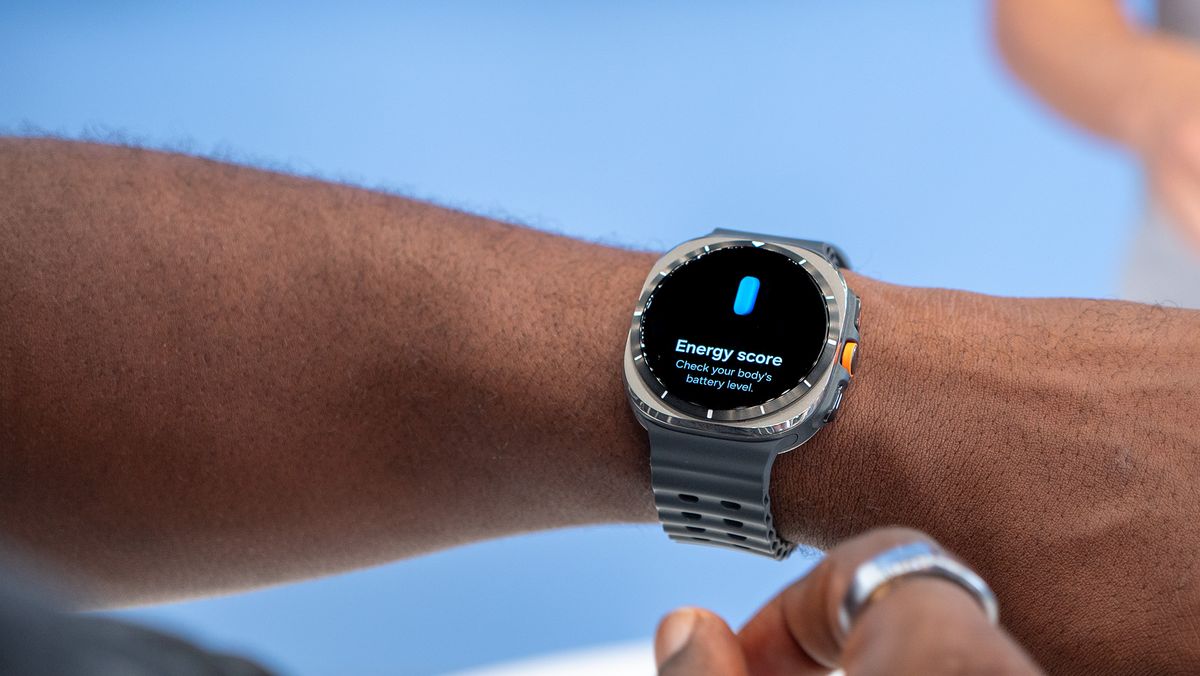
The Galaxy Watch Ultra is official, bringing with it a new design language for the first time in nearly a decade of Samsung Galaxy Watches. It's the direct challenger to the Apple Watch Ultra, all while remaining $150 cheaper than Apple's most expensive model.
Now, I don't know about you but when I think of a Samsung Galaxy smartwatch, the first thing that comes to mind is the circular design. The company didn't pioneer round smartwatches — that honor goes to the Moto 360 that debuted a full decade ago — but it certainly popularized them with fun hallmarks like a physically rotating bezel and a UI optimized for round screens.
Samsung isn't ditching the round screen just yet, something I'm pleased about, but it is squaring up the body to fit more electronics into a sleek yet rugged frame. Coupled with this is the addition of a new side key — simply called the Quick Button — that can be used for dozens of different customizable tasks.
It's also got a new hardened titanium frame, a new 3nm processor, more sensors than ever, and a guarantee that this is the most feature-rich smartwatch Samsung has ever produced.
Galaxy Watch Ultra: Price, availability, and bands
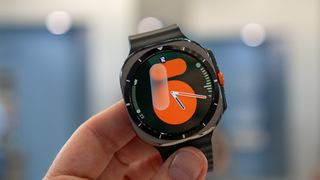
The Samsung Galaxy Watch Ultra ships in three colors: Titanium Gray, Titanium White, and Titanium Silver. All three colors feature a prominent orange Quick Button on the side. Preorders begin on July 10 for $649.99, and the watch ships in one size (47mm) with 2GB RAM and 32GB storage.
Samsung offers a range of band options made to fit the Galaxy Watch Ultra's bespoke dynamic lug system. The Marine band is a quick-drying band with a secure lock mechanism and dual adjustment holes per size to ensure it doesn't slip off no matter what you're doing.
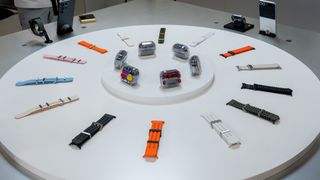
Trail is designed as a lighter weight cloth band that's breathable and easy to snap on and off, meant more for hikes and other activities that don't include a lot of sweeping arm movements. PeakForm is Samsung's all-purpose workout band that's designed to work as good as it looks.
Be an expert in 5 minutes
Get the latest news from Android Central, your trusted companion in the world of Android
Galaxy Watch Ultra is intended to be a new product line, not a replacement for the standard Galaxy Watch 7 or the Galaxy Watch 6 Classic with its rotating bezel.
Customers who order at Samsung.com can choose their own band when purchasing, ensuring you get the band you want right out of the box. Otherwise, the Watch Ultra will ship with the default silicone band at other retail outlets.
Unique, yet familiar design
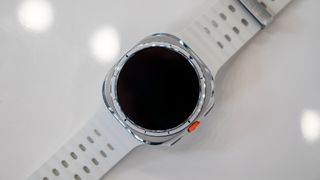
There's no denying the Apple Watch Ultra 2's influence on the Galaxy Watch Ultra. Not only does the Galaxy Watch Ultra use a square body but it's got a titanium frame and that trademark orange button. Even the default straps look nearly identical to the Apple Watch Ultra.
But, sometimes, imitation is the highest form of flattery. Apple somehow figured out how to sell a smartwatch for $800, so why wouldn't Samsung try to do something similar — albeit for a reduced price? The most immediate difference, of course, is that the watch display is still a circle, making it look more like a classic watch than a massive wrist computer.




Samsung calls this Cushion Design and it essentially apes the design language Samsung's One UI software has had for years. It doesn't change how you interact with the UI itself. Rather, it allows Samsung to pack in more sensors and electronics than it might in a fully circular watch where it would only be able to make it thicker or a wider diameter.





The new design hides the square body well by recessing it below the round display and ornate bezel.
As I was studying the watch being worn by several participants in the room for the hands-on, I noticed that it didn't look like a square at all. In fact, I would be hard pressed to identify this as anything other than circular from a distance, as the recessed rounded-square body helps hide its bulkier nature.
Strangely enough, despite being twice as heavy and noticeably larger than the Galaxy Watch 7 during my hands-on, I didn't feel like it was an overly bulky or massive watch. It's definitely both, don't get me wrong, but Samsung's design and rugged bands seemed to help with my perception here.





The new Quick Button is designed to be an action button for starting and pausing a workout, marking when a lap begins during a running or cycling workout.
It can even be used as an emergency alarm feature, emitting 85 decibels when held for 5 seconds. This could be helpful if you're out late at night and find yourself dealing with an unsafe situation, or if you get lost on a hike and need to make lots of noise so people can find you, for example.
There's no rotating crown or bezel on the Galaxy Watch Ultra, and I find the lack of tactile input very disappointing.
While all three side buttons line up evenly with the frame, the action button is the only one that's recessed. This doesn't make it hard to press by any means but its overtly bright orange color made it feel too much like a home button. I found myself constantly pressing it to go home during the hands on; I imagine this behavior would curb itself quickly after prolonged use, but it's annoying at the start.
Much to the chagrin of some, the bezel here doesn't rotate. There's not even a rotating crown or digital crown, meaning navigation is handled solely via button presses and touch screen swipes. I personally prefer a more physical rotating input for watches and found this lack of tactile input disappointing.
| Category | Description |
|---|---|
| Display | 1.5-inch Super AMOLED, 480 x 480 resolution, sapphire crystal |
| Processor | Exynos W1000 |
| RAM | 2GB |
| Storage | 32GB |
| Size | 47.4 x 47.1 x 12.1 mm |
| Bands | Dynamic Lug system |
| Weight | 60.5g |
| Colors | Titanium Gray, Titanium White, and Titanium Silver |
| Materials | Aerospace-grade Titanium frame, MIL-STD 810H hardened |
| Operating temperature | -4°F/-20°C to 131°F/55°C |
| Operating altitude | -330ft/100m to 29,500ft/9km |
| Battery | 590mAh (48-100 hours) |
| Charging | Fast charging |
| Software | One UI Watch 6 (Wear OS powered) |
| Communications | NFC, Bluetooth 5.3, 5G, Wi-Fi 2.4GHz and 5GHz |
| Sensors | Samsung BioActive Sensor (Optical Bio-signal sensor+ Electrical Heart Signal + Bioelectrical Impedance Analysis), Temperature Sensor, Accelerometer, Barometer, Gyro Sensor, Geomagnetic Sensor, Light Sensor |
| Water and dust resistance | IP68, 10 ATM waterproofing |
| Price | $649.99 |
The Samsung Galaxy Watch Ultra ships with a brand new quick release band system that is a pure joy to use. The button underneath releases the clip which makes removal dead simple. Likewise, bands simply click into place without any button presses, sliding, or anything even remotely complicated. The lugs feel tight and the recessed button ensures it shouldn't get accidentally pressed.






The Galaxy Watch Ultra has the largest battery of any Galaxy Watch to date, by far. At 590mAh, it's nearly twice the size of the 300mAh battery in the standard Galaxy Watch line, matching the Galaxy Watch 5 Pro.
Exercise power saving lets you exercise on a low battery without losing exercise tracking. This mode continues to measure your heart rate and also can still provide GPS tracking, albeit in low power mode — meaning it won't be as accurate as high-power dual-GPS tracking.
Samsung says this and other enhancements — plus that new processor and giant battery — give the Galaxy Watch Ultra 48-100 hour battery life depending on how you use it.
New health features
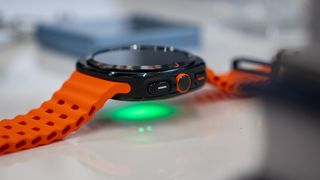
On the underside of the watch, Samsung packed in 3.2x the number of LEDs as previous Galaxy Watch models to help improve health metrics gathered from the sensors. Samsung said this helps improve the heart rate measurement during high-intensity workouts from 88% accuracy on the Galaxy Watch 6 up to 94% accuracy on the Galaxy Watch Ultra and Watch 7 series.
The new processor and new BioActive sensor also enables Samsung to run better algorithms to ensure that tracked heart rates aren't affected by "noise" that wrist-mounted sensors occasionally deliver.
The new sensor measures heart rates with up to 94% accuracy, compared to 88% on previous Galaxy Watch models.
The Galaxy Watch Ultra has been built with all sorts of extreme and endurance sports in mind, but Samsung has paid particular attention to athletes who spend a lot of time running or cycling.
Aerobic threshold and anaerobic threshold heart rate zones are monitored by the Galaxy Watch Ultra, helping long-distance runners, cyclists, and other endurance sports athletes train at their best. Samsung supports max heart rate, heart rate reserve, and AT/AnT heart rate measurements on the Galaxy Watch Ultra for these features. You can choose which you want to see on the watch in the heart rate zone settings.
Cyclists who want to check out the Galaxy Watch Ultra will likely also be thrilled at a new Functional Threshold Power Test which Samsung says can deliver personalized power recommendations for optimal efficiency. Samsung says it takes 4-10 minutes to assess this threshold, measuring faster than some more cumbersome professional equipment.
And everyone who likes to take regular circuits — whether that's running and cycling long distance or just jogging around your neighborhood — can enjoy the new race feature on the watch. This logs your time and distance via GPS tracking and will notify you in real time if you're doing better or worse than your previous best. It's a cool feature I'm betting our editor Michael Hicks is going to love when he gets his review unit.




The Galaxy Watch Ultra ships with a new dual GPS feature that ensures this should provide the most accurate GPS tracking of any Samsung Galaxy Watch on the market. The OnePlus Watch 2 was the first Wear OS smartwatch to launch with this feature but Samsung is playing quick catch-up.
The Galaxy Watch Ultra can also detect sleep apnea in people not previously diagnosed with the condition when worn regularly while sleeping. That's a cool new feature that's sure to come in handy for folks who might not realize they suffer from the condition.
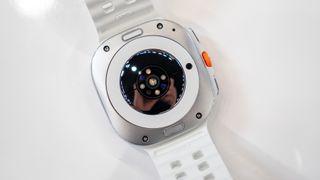
Samsung is using Galaxy AI to analyze exercise data and provide more meaningful insights and a new Energy Score, but it comes with one big caveat: you'll need a Galaxy S24 Ultra or another Samsung phone with Galaxy AI in order to use the feature.
My biggest complaint is that Samsung is only shipping the watch with 2GB of RAM and 32GB of storage.
That's because all the data analytics are handled locally via Galaxy AI instead of being uploaded to a server. Data is analyzed on your phone instead of the watch namely for battery life reasons. Energy Score and accompanying insights are the only Galaxy Watch Ultra exclusives that require a Samsung phone.
My biggest complaint is that Samsung shipped the watch with 2GB of RAM and 32GB of storage, same as the base Watch 7. From a spec level, this seems overly anemic for a watch that otherwise feels designed to replace the capabilities of a phone in many situations.
Time will tell if this pans out to be true, and we'll have a review for you in the near future to explore this (and other questions) more closely.

-
cknobman They figured out how to make the watch bigger, and uglier, without making the screen bigger.Reply
Seems like a win to me! :D
Keep my 5 another year. -
notforhire I'll continue to enjoy my 6 Classic for quite awhile longer, now. even if I needed an upgrade, the price is simply prohibitive. not gonna happen at that price point, even with generous trade-ins.Reply -
Bla1ze Looks pretty nice to me, but that price.. oof. Luckily, Samsung discounts just about everything anyway after a weeks but it's still a bit of a price creep.Reply -
sethm1 I am a pass on the whole 7 line. The ultra ugly. And none of the new watches have a physical bezel! Samsung you missed the mark all round this year.Reply -
Iphonenotdbest The ultra looks like my old Seiko kinetic watch. Mine is coming today.Reply
Love the new ultra.
364221